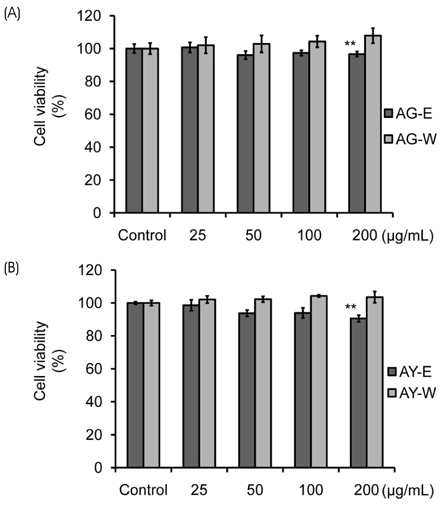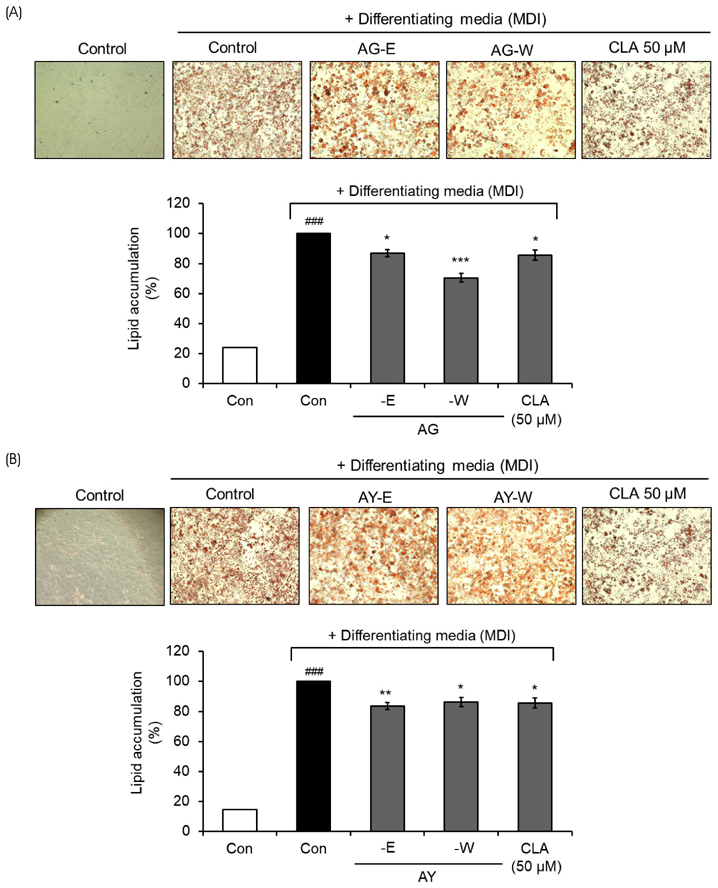J Nutr Health.
2019 Jun;52(3):250-257. 10.4163/jnh.2019.52.3.250.
Anti-oxidant and anti-adipocyte differentiation of Aster glehni and Aster yomena
- Affiliations
-
- 1Department of Herbal Crop Research, National Institute of Horticultural and Herbal Science, Eumsung, Chungbuk 27709, Korea. seokh@korea.kr
- 2Department of Food Science and Biotechnology, Chungbuk National University, Cheongju, Chungbuk 28644, Korea.
- KMID: 2450422
- DOI: http://doi.org/10.4163/jnh.2019.52.3.250
Abstract
- PURPOSE
Aster glehnii (AG) and Aster yomena (AY) are medicinal plants that belong to the family Compositea and grow widely in Korea. Plants in the genus Aster have been used to treat snakebite wounds or bruises in oriental medicine. This study compared the effects of anti-oxidants and anti-adipocyte differentiation according to the species (the aerial parts of AG and AY).
METHODS
AG and AY were extracted using 70% ethanol (−E) and water (−W) at room temperature. The anti-oxidant activities were measured by total phenol contents (TPC), total flavonoid contents (TFC), DPPH and ABTS+ assay. In addition, correlation analysis was performed for the anti-oxidant compounds and effect. The level of anti-adipocyte differentiation was assessed using an oil red O assay on pre-adipocytes.
RESULTS
AG-W showed higher TPC (6.92 µg/mL) and AG-E presented higher TFC (8.22 µg/mL) than the other extracts. Furthermore, AG-E exhibited higher radical scavenging activity in the DPPH and ABTS+ assay (IC50: 104.88 and 30.06 µg/mL). In the cytotoxicity assay, AG and AY extracts at concentrations less than 100µg/mL were non toxic. AG-W reduced the lipid accumulation of 3T3-L1 cells significantly after differentiation (70.49%) compared to the other extracts.
CONCLUSION
These results show that the water extract of AG has anti-oxidant effects and reduces the differentiation of 3T3-L1 cells. Therefore, AG has utility as a functional food material for its anti-oxidant activities and ability to prevent lipid accumulation.
MeSH Terms
Figure
Reference
-
1. Bessesen DH, Van Gaal LF. Progress and challenges in anti-obesity pharmacotherapy. Lancet Diabetes Endocrinol. 2018; 6(3):237–248.
Article2. Ministry of Health and Welfare (KR). Obesity prevalence trend [Internet]. Sejong: Ministry of Health and Welfare;2018. cited 2018 Nov 12. Available from: http://kosis.kr/statHtml/statHtml.do?orgId=117&tblId=DT_11702_N101.3. Ministry of Health and Welfare (KR). Korea Health Promotion Institution. The 4th National Health Promotion Plan (2016–2020). Sejong: Ministry of Health and Welfare;2015.4. World Health Organization. Obesity: preventing and managing the global epidemic. Report of a WHO consultation (WHO technical report series 894). Geneva: World Health Organization;2000.5. Yoo SJ. Pharmacological treatment of obesity. J Korean Endocr Soc. 2008; 23(4):223–233.
Article6. Hsu CL, Yen GC. Effects of flavonoids and phenolic acids on the inhibition of adipogenesis in 3T3-L1 adipocytes. J Agric Food Chem. 2007; 55(21):8404–8410.
Article7. Yang B, Chen H, Stanton C, Ross RP, Zhang H, Chen YQ, et al. Review of the roles of conjugated linoleic acid in health and disease. J Funct Foods. 2015; 15:314–325.
Article8. Hong SY, Cho KS, Yoo KO. Phylogenetic analysis of Korean native Aster plants based on internal transcribed spacer (ITS) sequences. Korean J Hort Sci Technol. 2012; 30(2):178–184.
Article9. Kim HH, Park GH, Park KS, Lee JY, An BJ. Anti-oxidant and anti-inflammation activity of fractions from Aster glehni Fr. Schm. Korean J Microbiol Biotechnol. 2010; 38(4):434–441.10. Ministry of Food and Drug Safety (KR). Food public code. Cheongju: Ministry of Food and Drug Safety;2018.11. Seo S, Lee KG, Shin JS, Chung EK, Lee JY, Kim HJ, et al. 6′-O-Caffeoyldihydrosyringin isolated from Aster glehni suppresses lipopolysaccharide-induced iNOS, COX-2, TNF-α, IL-1β and IL-6 expression via NF-κB and AP-1 inactivation in RAW 264.7 macrophages. Bioorg Med Chem Lett. 2016; 26(19):4592–4598.12. Kim KW, Shin JG, Lee DG. Isolation of herbicidal compound from Aster glehni Fr. Schm. Korean J Weed Sci. 2008; 28(4):434–441.13. Chung MS, Lee MS. Analysis of volatile flavor components of Aster glehni. Korean J Soc Food Sci. 1998; 14(5):547–552.14. Kim MH, Nugroho A, Choi JW, Park HJ. The extract of Aster glehni leaves rich in caffeoylquinic acids prevents atherogenic index, oxidative stress, and body weight increase in high-fat diet-induced rats. Korean J Pharmacogn. 2011; 42(1):54–60.15. Choi JH, Kim DW, Park SE, Choi BS, Sapkota K, Kim S, et al. Novel thrombolytic protease from edible and medicinal plant Aster yomena (Kitam.) Honda with anticoagulant activity: purification and partial characterization. J Biosci Bioeng. 2014; 118(4):372–377.
Article16. Sim JH, Lee HS, Lee S, Park DE, Oh K, Hwang KA, et al. Anti-asthmatic activities of an ethanol extract of Aster yomena in an ovalbumin-induced murine asthma model. J Med Food. 2014; 17(5):606–611.
Article17. Kim JS, Kim AY, Shin HM, Ahn SI, Shim HJ, Nam KW, et al. Aster yomena suppresses LPS-induced cyclooxygenase-2 and inducible nitric oxide synthase expression. Food Agric Immunol. 2017; 28(2):202–210.
Article18. Folin O, Denis W. On phosphotungstic-phosphomolybdic compounds as color reagents. J Biol Chem. 1912; 12(2):239–243.
Article19. Pourmorad F, Hosseinimehr S, Shahabimajd N. Antioxidant activity, phenol and flavonoid contents of some selected Iranian medicinal plants. Afr J Biotechnol. 2006; 5(11):1142–1145.20. Ko MS, Lee HJ, Kang MJ. Antioxidant activities and whitening effects of extracts from Hippophae rhamnoides L. J East Asian Soc Diet Life. 2012; 22(6):812–817.21. Ilavenil S, Arasu MV, Lee JC, Kim DH, Roh SG, Park HS, et al. Trigonelline attenuates the adipocyte differentiation and lipid accumulation in 3T3-L1 cells. Phytomedicine. 2014; 21(5):758–765.
Article22. Kim TW, Kim KK, Kang YH, Kim DJ, Choe M. Fatty acid analysis and regulatory effects of citron (Citrus junos Sieb. ex TANAKA) seed oil on nitric oxide production, lipid accumulation, and leptin secretion. J Nutr Health. 2014; 47(4):221–228.23. Kim KB, Jang SH. Anti-obesity effect of EGCG and glucosamine-6-phosphate through decreased expression of genes related to adipogenesis and cell cycle arrest in 3T3-L1 adipocytes. J Nutr Health. 2014; 47(1):1–11.
Article24. Malich G, Markovic B, Winder C. The sensitivity and specificity of the MTS tetrazolium assay for detecting the in vitro cytotoxicity of 20 chemicals using human cell lines. Toxicology. 1997; 124(3):179–192.
Article25. Jang M, Hong E, Cheong JH, Kim GH. Antioxidative components and activity of domestic Cirsium japonicum extract. J Korean Soc Food Sci Nutr. 2012; 41(6):739–744.
Article26. Treutter D. Significance of flavonoids in plant resistance: a review. Environ Chem Lett. 2006; 4(3):147–157.
Article27. Choi HY. Antioxidant activity and quality characteristics of pine needle cookies. J Korean Soc Food Sci Nutr. 2009; 38(10):1414–1421.
Article28. Alara OR, Abdurahman NH, Mudalip SK, Olalere OA. Characterization and effect of extraction solvents on the yield and total phenolic content from Vernonia amygdalina leaves. J Food Meas Charact. 2018; 12(1):311–316.
Article29. Re R, Pellegrini N, Proteggente A, Pannala A, Yang M, Rice-Evans C. Antioxidant activity applying an improved ABTS radical cation decolorization assay. Free Radic Biol Med. 1999; 26(9-10):1231–1237.
Article30. Cho M, Lee HJ, Kang MH, Min H. Comparison of antioxidant activity and prevention of lymphocyte DNA damage by fruit and vegetable juices marketed in Korea. J Nutr Health. 2017; 50(1):1–9.
Article31. Ruiz-Ojeda FJ, Rupérez AI, Gomez-Llorente C, Gil A, Aguilera CM. Cell models and their application for studying adipogenic differentiation in relation to obesity: a review. Int J Mol Sci. 2016; 17(7):E1040.
Article32. Park SY, Hwang HY, Seo EA, Kwon KB, Ryu DG. Inhibition effects of Galla Chinenisis extract on adipocyte differentiation in OP9 cell. Korean J Orient Physiol Pathol. 2012; 26(4):455–461.33. Oh JH, Lee Y. Effects of water and ethanol extracts from four types of domestic seaweeds on cell differentiation in 3T3-L1 cell line. J East Asian Soc Diet Life. 2015; 25(6):990–998.
Article
- Full Text Links
- Actions
-
Cited
- CITED
-
- Close
- Share
- Similar articles
-
- LC–MS/MS-Based Comparative Investigation on Chemical Constituents of Six Aster Species Occurring in Korea
- Aster glehni Ethanol Extract Inhibits Inflammatory Responses Regulating Skin Barrier Molecules in Human Keratinocytes
- Occurrence of Stem Rot of Wild Aster (Aster koraiensis) Caused by Sclerotium rolfsii in Korea
- Stem Rot of Tatarian Aster (Aster tataricus) Caused by Sclerotium rolfsii in Korea
- Hypouricemic Effect of Ethanol Extract of Aster glehni Leaves in Potassium Oxonate-Induced Hyperuricemic Rats




